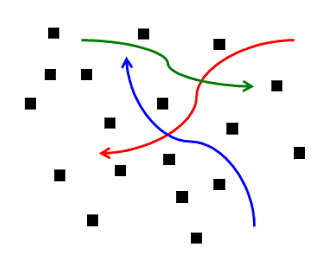I've been thinking, again.
One of my favourite things to do is to reflect on the past and how we came to be. It all started off 4,6 billion years ago. Oxygen came into the air 2,3 billion years ago. We got ozon and life took off. Earth has know 5 big mass extinctions. The last one killed the dinosaurs, approximately 65 million years ago. We, humans, appeared 200.000 years ago. Since then, the time scale has been speeding up. Especially when we, around 5200 years ago, started to write things down. And the influence of humans on the globe has grown so big that our era is called the "antropoceen". Scientists don't agree on the exact date but its start is situated around the industrial revolution, around the 1800's. Isaac Newton is considered to be a key figure in this scientific revolution. He lived one hundred years earlier.
At the beginning of the 20th century Albert Einstein thought that Newtonian mechanics were no longer enough to reconcile the laws of classical mechanics with the laws fo the electromagnetic field. He created his special theory of relativity. Since then, scientists have been digging into the world of quantumphysics. And, now, again one hundred years later this is having a tremendous impact on the way we organise our economy.
I describe "mechanical thinking" as serial, on a need to know basis and about one certainty for all. It's the engine of the first train in a world where we, humans, thought to have figured it all out. This is where most of our business models are based upon, certainly in the world of construction.
Quantum mechanics is a totally different thing: the smallest of objects are wave and particle at the same time. Looking at it as a particle, the wave disappears. Observing the wave and the particle is never to be found. Things appear to be at different places at the same time and nothing is certain. It's all about probability, nothing is certain anymore. Scientists are still puzzled by it but most of our latest technology is based on quantum mechanics.
Therefor "Quantum thinking" is random, with all information available at any given moment in space-time and customized solutions. A nightmare for present day organisations who earn their money by intellectual property.
Both designers and contractors are going to learn to deal with this.
Starting with the classic bill of quantities.
Simplified it looks a bit like this:

A tree structure where the red lines are supposed to deliver knowledge concerning sales for the developper, the blue lines to deliver financial figures according to the model of the designers and the green lines a shopping list for the contractor. As we all know, the only thing this bill of quantities delivers is a basis for a contract and an enormous monthly burden for the administration without gaining any knowledge for future projects.
We need to organise our information so that the developper, when considering his sale options, can distinguish the cost of private areas to be sold and the cost of areas who belong to the community. And when the designer is asked about the price of a particular window in his model, that this is generated by one click of a buttton, with ALL the feature that comes along (so not only the window itself). The same goes for the contractor when he wants to know how many cubic meter of soil he needs to move.
Putting this all in a sketch, it looks like this:

The black dots are the information and the keypartners are swarming around it to collect their data and knowledge. As with lockhursts, it won't be a pretty sight at first: the lockhursts literally eat each others wings and legs to find a spot where they feel comfortable. But when the swarm grows into miljons, they get organised and perform the most beautifull dance.
Two weeks ago I gave an in company training on quantity survey and estimating. They looked dazzled but once the sketch filled with standards appeared, they got it and knew where their spot was. This is it: BouwData (and 5D BIM for the estimator / budgetcontroller) in a sketch:

It ain't easy but it certainly helps to gain knowledge and to communicate with other keypartners in the world of design, construction and facility management.
And for those still looking for one bill of quantities: take the blue circle because this is about life cycle cost and when every keypartners stretches a little bit, it's a good starting point for communication. But don't think you can do without the red, green and grey circle.
